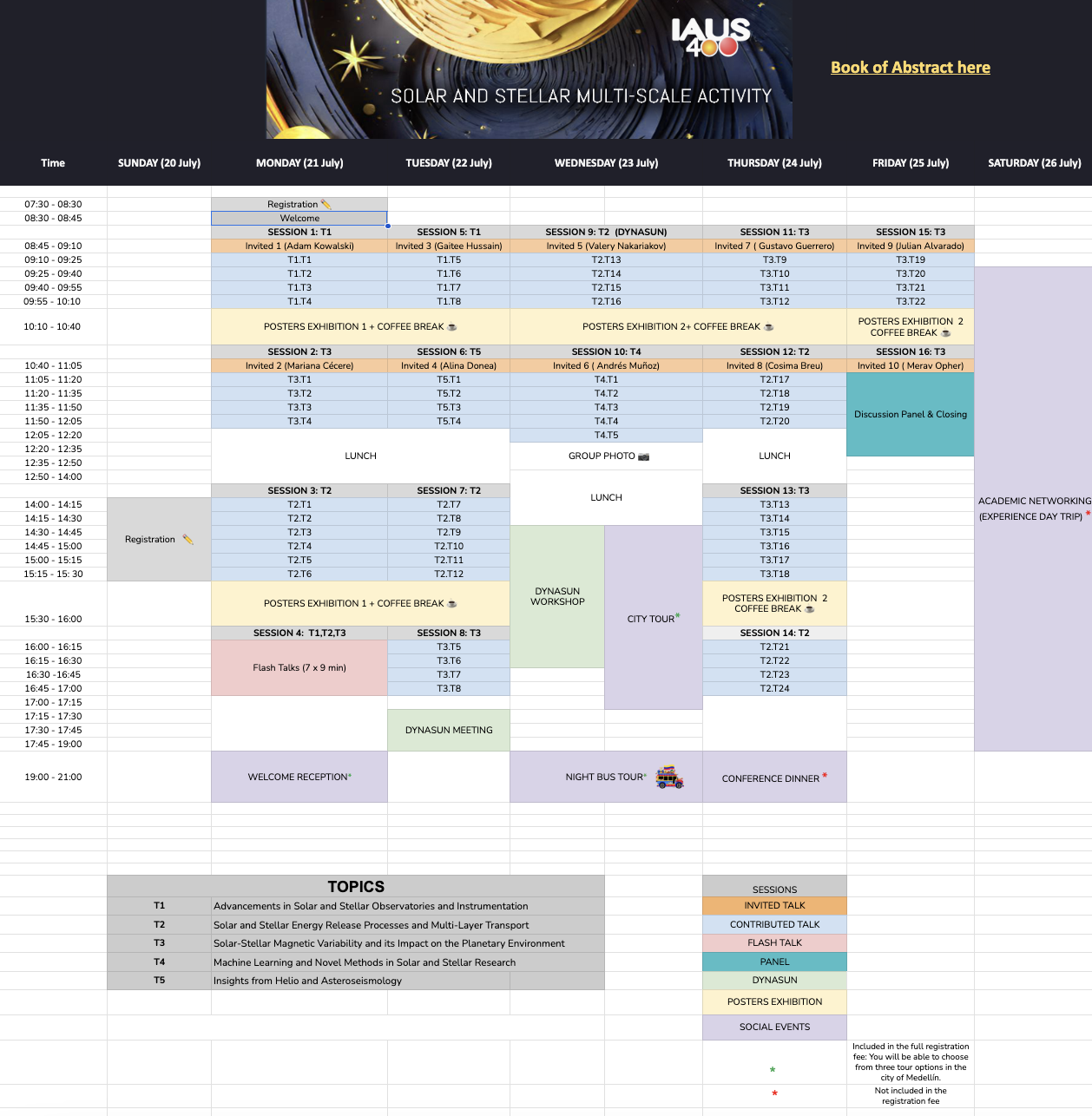Preliminary Agenda
PROGRAM
The IAUS400 Symposium will feature a rich schedule that includes invited talks, contributed presentations, poster sessions, discussion panels, and social events. Each day begins with keynote lectures and scientific presentations, followed by poster exhibitions and coffee breaks. Afternoon sessions continue with more presentations and themed sessions, including the DynaSun Workshop.
🔗 Program Schedule
🔗 Program by day
🔗 Book of Abstracts
Special activities include an Academic Networking Day Trip, a group photo, a City Tour of Medellín, and social gatherings such as the Welcome Reception and the Conference Dinner. The program also includes flash talks, a closing panel discussion, and a wide range of sessions organized around five main scientific themes:
T1: Advancements in Solar and Stellar Observatories and Instrumentation
T2: Solar and Stellar Energy Release Processes and Multi-Layer Transport
T3: Solar-Stellar Magnetic Variability and Its Impact on the Planetary Environment
T4: Machine Learning and Novel Methods in Solar and Stellar Research
T5: Insights from Helio- and Asteroseismology
INVITED SPEAKERS
We are pleased to introduce our confirmed invited speakers for IAUS400. These outstanding scientists represent a diversity of institutions and research topics across solar and stellar astrophysics. Their participation will enrich the discussions and foster collaborations within our international community. Adam Kowalski (University of Colorado, Boulder - United States)
Dr. Kowalski will present recent advances in solar-stellar flare research, including the observational characterization and modeling of energetic events on stars.
Gaitee Hussain (European Space Agency – ESA)
Dr. Hussain is responsible for maximising the scientific return across all ESA science missions, working closely with scientific communities to help identify their priorities and implement new mission concepts.
Valery Nakariakov (University of Warwick - United Kingdom)
A leading expert in magnetohydrodynamics, Dr. Nakariakov will share his work on wave processes in the solar atmosphere.
Mariana Cécere (Instituto de Astronomía Teórica y Experimental - Argentina)
Dr. Cécere investigates the topology of successful and failed coronal mass ejections (CMEs) in Sun-like stars, contributing to our understanding of stellar eruptive events.
Cosima Breu (University of Graz- Austria)
Dr. Breu will present on coronal heating, addressing one of the most fundamental challenges in solar physics.
Julián Alvarado (Leibniz Institute for Astrophysics Potsdam (AIP) - Germany)
Dr. Alvarado-Gómez studies stellar magnetic variability and its influence on the exoplanetary environment, connecting stellar activity with planetary habitability.
Gustavo Guerrero (Universidade Federal de Minas Gerais - Brazil)
Dr. Guerrero focuses on deep and surface dynamo processes and their influence on magnetic variability in the Sun and stars.
Merav Opher (Boston University - United States)
Dr. Opher leads the SHIELD project and will present a new predictive global model for the heliosphere, with implications for space weather and heliophysics.
Andrés Muñoz Jaramillo (Southwest Research Institute - United States)
Dr. Muñoz Jaramillo applies machine learning techniques to the study of the solar activity cycle, integrating data science into solar physics.
Alina Donea (Monash University - Australia)
Dr. Donea contributes to the understanding of solar acoustic waves and helioseismic responses to flares.
The IAUS400 Symposium will feature a rich schedule that includes invited talks, contributed presentations, poster sessions, discussion panels, and social events. Each day begins with keynote lectures and scientific presentations, followed by poster exhibitions and coffee breaks. Afternoon sessions continue with more presentations and themed sessions, including the DynaSun Workshop.
🔗 Program Schedule
🔗 Program by day
🔗 Book of Abstracts
Special activities include an Academic Networking Day Trip, a group photo, a City Tour of Medellín, and social gatherings such as the Welcome Reception and the Conference Dinner. The program also includes flash talks, a closing panel discussion, and a wide range of sessions organized around five main scientific themes:
T1: Advancements in Solar and Stellar Observatories and Instrumentation
T2: Solar and Stellar Energy Release Processes and Multi-Layer Transport
T3: Solar-Stellar Magnetic Variability and Its Impact on the Planetary Environment
T4: Machine Learning and Novel Methods in Solar and Stellar Research
T5: Insights from Helio- and Asteroseismology
INVITED SPEAKERS
We are pleased to introduce our confirmed invited speakers for IAUS400. These outstanding scientists represent a diversity of institutions and research topics across solar and stellar astrophysics. Their participation will enrich the discussions and foster collaborations within our international community. Adam Kowalski (University of Colorado, Boulder - United States)
Dr. Kowalski will present recent advances in solar-stellar flare research, including the observational characterization and modeling of energetic events on stars.
Gaitee Hussain (European Space Agency – ESA)
Dr. Hussain is responsible for maximising the scientific return across all ESA science missions, working closely with scientific communities to help identify their priorities and implement new mission concepts.
Valery Nakariakov (University of Warwick - United Kingdom)
A leading expert in magnetohydrodynamics, Dr. Nakariakov will share his work on wave processes in the solar atmosphere.
Mariana Cécere (Instituto de Astronomía Teórica y Experimental - Argentina)
Dr. Cécere investigates the topology of successful and failed coronal mass ejections (CMEs) in Sun-like stars, contributing to our understanding of stellar eruptive events.
Cosima Breu (University of Graz- Austria)
Dr. Breu will present on coronal heating, addressing one of the most fundamental challenges in solar physics.
Julián Alvarado (Leibniz Institute for Astrophysics Potsdam (AIP) - Germany)
Dr. Alvarado-Gómez studies stellar magnetic variability and its influence on the exoplanetary environment, connecting stellar activity with planetary habitability.
Gustavo Guerrero (Universidade Federal de Minas Gerais - Brazil)
Dr. Guerrero focuses on deep and surface dynamo processes and their influence on magnetic variability in the Sun and stars.
Merav Opher (Boston University - United States)
Dr. Opher leads the SHIELD project and will present a new predictive global model for the heliosphere, with implications for space weather and heliophysics.
Andrés Muñoz Jaramillo (Southwest Research Institute - United States)
Dr. Muñoz Jaramillo applies machine learning techniques to the study of the solar activity cycle, integrating data science into solar physics.
Alina Donea (Monash University - Australia)
Dr. Donea contributes to the understanding of solar acoustic waves and helioseismic responses to flares.
